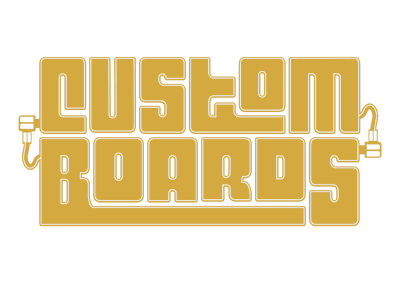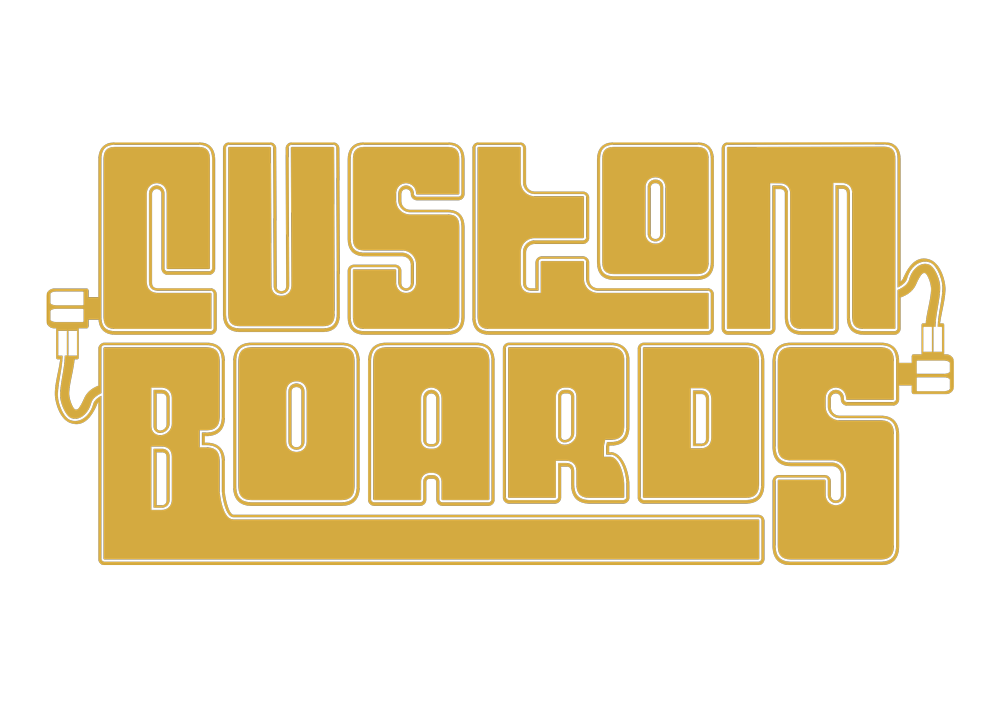Installing the patch cables to the pedalboard with Custom Boards "Safety" connectors
At Custom Boards we always make a point of routing all patch cables in the straightest way, avoiding any sharp angles. The cabling should be neat and linear, and all corners taken in round curves.
The way we dress our patch cables owes a lot to the way boutique-class point-to-point guitar amps are built – all routing is neat, involving well thought through strain relief.
When you think of it, a pedalboard isn’t that much different from an amp, which means that the cabling should be just as good. Here are some of the similarities:
- A power supply unit is like an amp’s main transformer, and it should be kept away from the pedal’s audio signal.
- A line level signal would be much less susceptible to induced noise, but a guitar output runs at low instrument levels.
- Effect pedals can be compared to the preamp valves (tubes). Especially boosters amplify the signal, even lifting it up to a live level signal, which is much less prone to induced buzz. If there’s enough amplification in the board’s signal chain, the signal will leave the board much less vulnerable.

Taking our amp/pedalboard-analogy a bit further we could think about how long it would take before an amp’s signal would deteriorate, or even drop out, if all connections inside an amp head were made using phone plugs and jacks, instead of solder.
As their name suggests, phone plugs were originally developed for operator switchboards – easy to plug in and out for fast telephone connections. The more you think about it, you will realize how important it is to make all patch cable connections as “solid” as possible.
No patch cable should pop out, even when you throw your board against the wall. The most common causes of pedalboard malfunctions are loose cables.
Theoretically you could go and hardwire your board by soldering all patch cables to the effects’ inputs, or even straight to each effect’s circuit board. With a lot of care – and with effect pedals that never break – you could achieve very good results.
But as we all know, most musicians will want to try different pedals somewhere down the line, which makes hardwiring extremely impractical.
However, we can take a lot of inspiration from this idea. We should aim for maximum reliability in our patch cable connections, by making sure our plugs will stay safely in place under any circumstances. Well-dressed patch cables both look great and provide ultimate reliability.

Custom Boards Safety Clips
Our clips make sure your cables will stay plugged in. They prevent many problems and keep your pedalboard reliable. The clips will also keep the cables in their predetermined places, so they won’t wander off towards the PSU or beneath your wah-wah.

We offer three different Safety Clip types:
– Custom Boards 26 mm Safety Clips are used for routing groups of cables along the underside of the board’s frame. To make this larger clip fit perfectly to the underside of Pedaltrain frames, you should cut off the part of the plastic foot behind the back of the clip with a wire cutter or a pair of solid, quality scissors.
Leaving the bit in place will push part of the adhesive pad over the frame’s edge, which doesn’t look nice, and also leaves the clip hanging less securely and prone to gather dust etc.
– Custom Boards 19 mm Safety Clips are best for installing single patch or a couple of power supply cables.
– The Custom Boards Safety Anchor together with included cable ties are great for bundling power supply cables. Using the other clip sizes can easily leave the cables either too loose or rather squeezed.

The power connections are usually more permanently installed than patch cables. There’s quite a lot of them near the PSU, and they are only seldom replaced.
Our Safety Anchors are also handy at busy crossings with a larger number of cables. Setups using an effect looper also often need Safety Anchors.
How many clips do I need?
- For a small board you will need a single bag of Safety Clips and Safety Anchors each.
- Medium-sized boards require a second bag of Safety Clips.
- Very large pedalboards need three bags of Safety Clips and two bags of Safety Anchors.
Installations using Safety Anchors and cable ties are more permanent than using the clips, which is why we don’t recommend this method for patch cables, even though this is quite common around the world. Should a pedal become defective, you will want to unplug and reroute the patch cable as quickly as possible. A Safety Clip allows you to do just that, while the Safety Anchors are a better choice for permanently installing larger groups of cables.
Frame surfaces
All our clips will only stick to smooth and clean surfaces. Using our clips is the main reason why we at Custom Boards don’t recommend Velcro-covered pedalboard frames.

True, you could attach a piece of Velcro to each clip, but Velcro won’t be as strong as the adhesive on a smooth surface, negating most of the clip’s advantages. If a clip is under constant stress or torque in a certain spot on the board, you can use super glue to install the clip. We’d also suggest using super glue for attaching the clip that holds the cable loom’s cables in place.
Cable routing beneath the board
The routing and dressing of a board’s patch cables is the most demanding, interesting, and also the most rewarding phase in the building process. You’re aiming for a clean and neat look, combined with the highest possible reliability.
We have to take into account all the possible problem sources we’ve detected during our first batch of tests. Don’t install patch cables where they will pick up hum or buzz.

You have to consider the natural push and pull on each cable during installation, and especially when attaching them to the board using the clips.
Routing and dressing patch cables is extremely tedious and pedantic work, but there’s a positive therapeutic aspect, too. This phase will bring out your personal touch, and the result will please the eye. The best patch cable routings are like little works of art – full of personality and beauty.
Try to achieve a positive flow during this phase. Put on some calming music, and try to enjoy placing the cables. This isn’t only electronics, this is a spiritual happening – you’re on a quest for the ultimate in pedalboard feng shui!
- Place some foam or a towel on top of your workbench to protect your pedals, as you will be working on the board while it’s upside down.
- Remove all of the bits of masking tape from the patch cables.
Should you want to stay informed about which cable goes where, you could use coloured electrician’s tape to mark the cables before removing the masking tape pieces. Earlier we’ve used this method ourselves, but the improved quality of patch cables makes this redundant in our view. It’s much more important to indicate the order of all the effect pedals, and which PSU cable is connected to which effect.
SquarePlug has come up with an interesting idea to mark the cables. They offer a selection of anodized screws for their connector plugs in many different colors, witch which you can mark patch cables with ease and style.
- Plan your cable layout thoroughly, and try to determine the best spots for clips, without actually sticking them on, yet. If it makes things easier, you could mark out the best spots using a Stagetrix Settings Saver marker. This also gives you a chance to change your mind, before committing to a spot.
- Start by trying to imagine the “big picture”; details will be worked out along the way.
- Remember to leave enough slack for each connector. This will keep the plugs from pulling on the jacks, and it will also make it much easier to disconnect a cable in case of an emergency. A curve of approximately two centimetres next to the plug will usually do.
- Once you’ve worked out the main aspects of your cable routing, it is time to start the installation.
Attaching the clips
It’s usually best to start at the busiest point of the board, and then continuing outwards. You can add additional clips where they’re needed. Again, take care of the big picture first, and then continue by attaching single cables.
If you are using two power supply outputs for a single pedal, secure the splitter´s connection with electrician’s tape. In the best case both PSU connectors are straight plugs, and the angled plug goes to the pedal. Add two 26 mm Safety Clips side-by-side to secure the connection.
You can bundle spare power supply cables into dense bundles, and attach them to the frame using two Safety Anchors and cable ties. Don’t tighten the cable ties too much, or you might damage the cables’ insulations. Make sure that there’s enough slack in the signal and power cables near each pedal.
- Tighten the cable ties and cut off the spare ends, once all patch cables are in their final place.
- Pay attention to securing all the effects’ power cables with clips placed next to their base plates. You don’t want any power plug to be disconnected by mistake.
- Pull off the masking tape with your power output markings from the PSU, and stick it to the side of the pedalboard as a reminder.

- Mark all PSU outputs using the labels printed earlier, after what you can discard the masking tape strip for good.
*****
If you have purchased all the parts and components but get a feeling that you might not be up to the task after all, we can make your pedalboard for you, using the components you have bought from us. Don’t worry, we won’t let anything go to waste.













